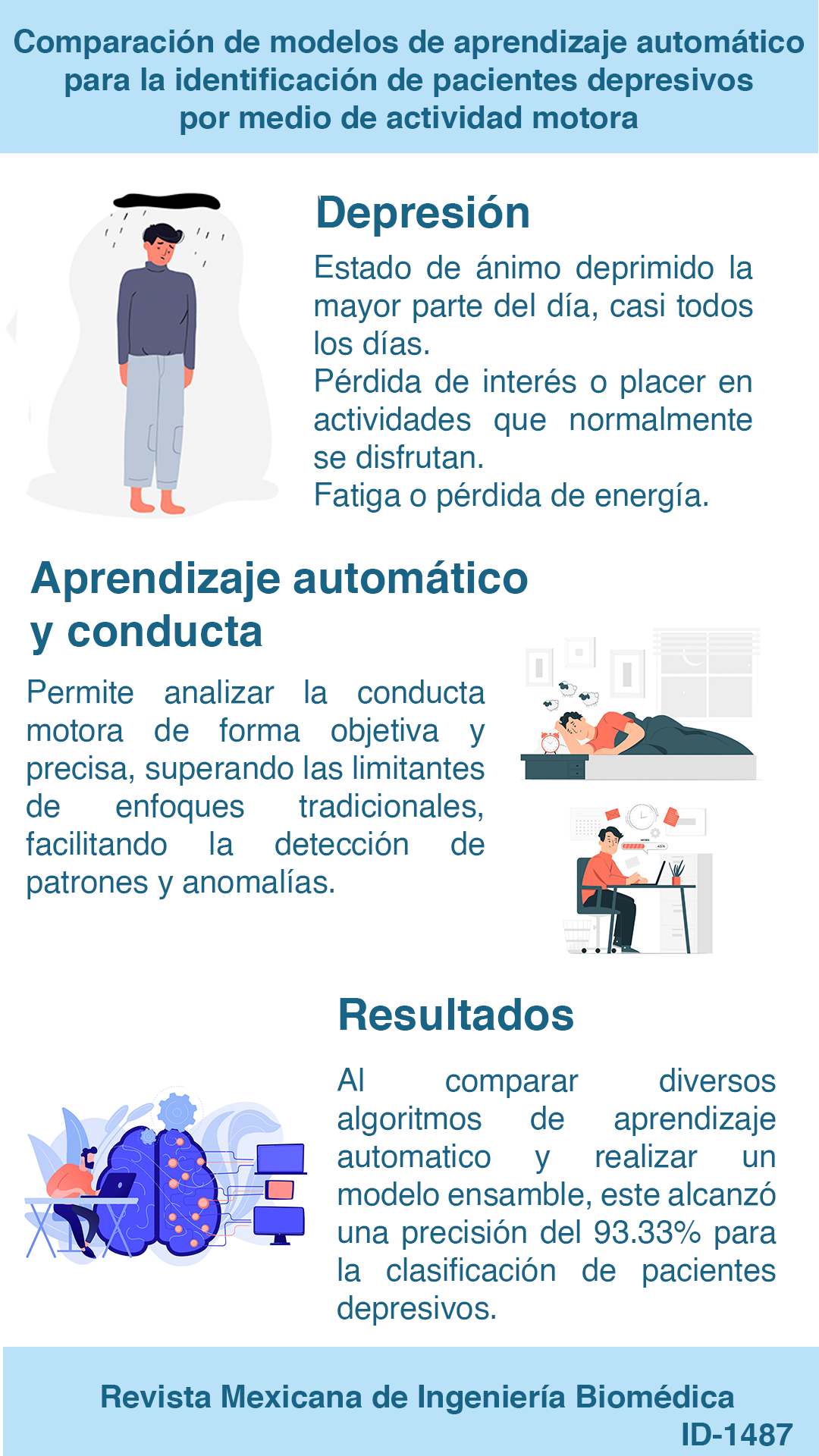Comparison of Machine Learning Models for Identification of Depressive Patients through Motor Activity
DOI:
https://doi.org/10.17488/RMIB.46.1.1487Keywords:
data mining, data analysis, depression, machine learning and motor activityAbstract
The present study aims to evaluate various classification algorithms for data pertaining to subjects diagnosed with depression and non-depressive subjects. To this end, the data obtained from the "depresjon" dataset proposed by Garcia-Ceja, E., et al were analyzed. This dataset comprises motor activity recorded by the Actiwatch device (Cambridge Neurotechnology Ltd, England, model AW4). Predictions were made using various machine learning models, including synthetic data. Subsequently, metrics such as specificity, sensitivity, and precision were compared. The results highlight the best features of the data and the best machine learning model (using an ensemble model) for classifying potential depressive episodes in activity during the afternoon and night, with a precision of 96.6 %, sensitivity of 100 %, and specificity of 93.33 %.
Downloads
References
M. E. Morris and A. Aguilera, “Mobile, social, and wearable computing and the evolution of psychological practice,” Prof. Psychol. Res. Pract., vol. 43, no. 6, pp. 622-626, 2012, doi: https://doi.org/10.1037/a0029041
C. A. Woody et al., “A systematic review and meta-regression of the prevalence and incidence of perinatal depression,” J. Affect Disord, vol. 219, pp. 86-92, 2017, doi: https://doi.org/10.1016/j.jad.2017.05.003
J. G. Rodríguez-Ruiz et al., “Comparison of night, day and 24 h motor activity data for the classification of depressive episodes,” Diagnostics (Basel), vol. 10, no. 3, 2020, art. no. 162, doi: https://doi.org/10.3390/diagnostics10030162
I. V. Vahia and D. D. Sewell, “Late-life depression: a role for accelerometer technology in diagnosis and management,” Amer. J. Psychiatry, vol. 173, no. 8, pp. 763-768, 2016, doi: https://doi.org/10.1176/appi.ajp.2015.15081000
A. Abd-Alrazaq et al., “Wearable artificial intelligence for anxiety and depression: scoping review,” J. Med. Internet Res., vol. 25, 2023, art. no. e42672, doi: https://doi.org/10.2196/42672
E. Garcia-Ceja et al., “Depresjon: a motor activity database of depression episodes in unipolar and bipolar patients,” in Proc. 9th ACM Multimedia Syst. Conf., Amsterdam, Netherlands , 2018, pp. 472-477, doi: https://doi.org/10.1145/3204949.3208125
A. Massaro et al., “Decisional support system with artificial intelligence oriented on health prediction using a wearable device and big data,” in 2020 IEEE Int. Workshop Metrol. Ind. 4.0 & IoT, Roma, Italy, 2020, pp. 718-723, doi: https://doi.org/10.1109/MetroInd4.0IoT48571.2020.9138258
D. Wang, J. Weng, Y. Zou, and K. Wu, “EmoTracer: a wearable physiological and psychological monitoring system with multi-modal sensors,” in Adjunct Proceedings of the 2022 ACM International Joint Conference on Pervasive and Ubiquitous Computing and the 2022 ACM International Symposium on Wearable Computers, New York, NY, USA, 2022, pp. 444-449, doi: https://doi.org/10.1145/3544793.3560409
P. M. Singh and P. Sathidevi, “Design and implementation of a machine learning-based technique to detect unipolar and bipolar depression using motor activity data,” in Smart Trends in Computing and Communications, vol. 286, 2021, pp. 99-107, doi: https://doi.org/10.1007/978-981-16-4016-2_10
C. Iribarne, V. Renner, C. Pérez, and D. L. de Guevara, “Trastornos del Ánimo y Demencia. Aspectos clínicos y estudios complementarios en el diagnóstico diferencial,” Rev. Méd. Clín. Las Condes, vol. 31, no. 2, pp. 150-162, 2020, doi: https://doi.org/10.1016/j.rmclc.2020.02.001
G. Jackson-Koku, “Beck Depression Inventory,” Occup. Med., vol. 66, no. 2, pp. 174-175, 2016, doi: https://doi.org/10.1093/occmed/kqv087
J. Morrison. DSM-5® Guía para el diagnóstico clínico. (2015). [Online]. Available: https://cdn.website-editor.net/50c6037605bc4d1e9286f706427108e6/files/uploaded/DSM-5%2520guia%2520para%2520el%2520diagnstico%2520clinico%2520-%2520James%2520Morrison.pdf.
J. Davidson et al., “The Montgomery‐Åsberg Depression Scale: reliability and validity,” Acta Psychiatr. Scand., vol. 73, no. 5, pp. 544-548,1986, doi: https://doi.org/10.1111/j.1600-0447.1986.tb02723.x
World Health Organization, 2015, “International statistical classification of diseases and related health problems,” distributed by World Health Organization, https://iris.who.int/handle/10665/246208.
S. Saeb et al., “The relationship between clinical, momentary, and sensor-based assessment of depression,” in 2015 9th International Conference on Pervasive Computing Technologies for Healthcare (PervasiveHealth), Istanbul, Turquía, 2015, doi: https://doi.org/10.4108/icst.pervasivehealth.2015.259034
Z. Y. Wee et al., “Actigraphy studies and clinical and biobehavioural correlates in schizophrenia: a systematic review,” J. Neural. Transm., vol. 126, no. 5, pp. 531-558, 2019, doi: https://doi.org/10.1007/s00702-019-01993-2
J. O. Berle et al., “Actigraphic registration of motor activity reveals a more structured behavioural pattern in schizophrenia than in major depression,” BMC Res. Notes, vol. 3, no. 1, 2010, art. no. 149, doi: https://doi.org/10.1186/1756-0500-3-149
R. Ramakrishnan et al., “Accelerometer measured physical activity and the incidence of cardiovascular disease: Evidence from the UK Biobank cohort study,” PLoS Med., vol. 18, no. 1, 2021, art. no. e1003487, doi: https://doi.org/10.1371/journal.pmed.1003487
B. Helgadóttir, Y. Forsell, and Ö. Ekblom, “Physical activity patterns of people affected by depressive and anxiety disorders as measured by accelerometers: a cross-sectional study,” PLoS One, vol. 10, no. 1, 2015, art. no. e0115894, doi: https://doi.org/10.1371/journal.pone.0115894
A. C. Cote et al., “Evaluation of wearable technology in dementia: a systematic review and meta-analysis,” Front. Med., vol. 7, 2021, art. no. 501104, doi: https://doi.org/10.3389/fmed.2020.501104
V. Trevino and F. Falciani, “GALGO: an R package for multivariate variable selection using genetic algorithms,” Bioinformatics, vol. 22, no. 9, pp. 1154-1156, 2006, doi: https://doi.org/10.1093/bioinformatics/btl074
W. S. Noble, “What is a support vector machine?,” Nat. Biotechnol., vol. 24, no. 12, pp. 1565-1567, 2006, doi: https://doi.org/10.1038/nbt1206-1565
B. E. Boser, I. M. Guyon, and V. N. Vapnik, “A training algorithm for optimal margin classifiers,” in Proc. COLT92 5th. Annu. Workshop Comput. Learn. Theory, Pittsburgh, PA, USA, 1992, pp. 144-152, doi: https://doi.org/10.1145/130385.130401
A. Krogh, “What are artificial neural networks?,” Nat. Biotechnol., vol. 26, no. 2, pp. 195-1977, 2008, doi: https://doi.org/10.1038/nbt1386
G. Guo et al., “KNN model-based approach in classification,” in On The Move to Meaningful Internet Systems 2003: CoopIS, DOA, and ODBASE, Sicily, Italy, vol. 2888, 2003, pp. 986-996, doi: https://doi.org/10.1007/978-3-540-39964-3_62
B. Mahesh et al., “Machine learning algorithms-a review,” Int. J. Sci. Res., vol. 9, no. 1, pp. 381-386, 2020, doi: https://doi.org/10.21275/ART20203995
M. Gashler, C. Giraud-Carrier, and T. Martinez, “Decision tree ensemble: Small heterogeneous is better than large homogeneous,” in 2008 7th Int. Conf. Mach. Learn. Appl., San Diego, CA, USA, 2008, pp. 900-905, doi: https://doi.org/10.1109/ICMLA.2008.154
A. B. Shaik and S. Srinivasan, “A brief survey on random forest ensembles in classification model,” in Proc. 2018 Int. Conf. Innov. Comput. Commun., vol. 56, Nov. 2018, pp. 253-260, doi: https://doi.org/10.1007/978-981-13-2354-6_27
L. Pietruczuk, L. Rutkowski, M. Jaworski, and P. Duda, “How to adjust an ensemble size in stream data mining?,” Inf. Sci., vol. 381, pp. 46-54, 2017, doi: https://doi.org/10.1016/j.ins.2016.10.028
S. Chetlur et al., Dec. 2014, “ccuDNN: Efficient primitives for deep learning,” 2014, arXiv:1410.0759, doi: https://doi.org/10.48550/arXiv.1410.0759
A. C. Davison and D. V. Hinkley, Bootstrap methods and their application (Cambridge Series in Statistical and Probabilistic Mathematics). New York, NY, USA: Cambridge University press, 1997, doi: https://doi.org/10.1017/CBO9780511802843
Y. Xie et al., “Stacking ensemble learning models for daily runoff prediction using 1D and 2D CNNs,” Expert Syst. Appl., vol. 217, 2023, art. no. 119469, doi: https://doi.org/10.1016/j.eswa.2022.119469
I. M. Lin et al., “Prefrontal Lobe and Posterior Cingulate Cortex Activations in Patients with Major Depressive Disorder by Using Standardized Weighted Low-Resolution Electromagnetic Tomography,” J. Pers. Med., vol. 11, no. 11, 2021, art. no. 1054, doi: https://doi.org/10.3390/jpm11111054
S. Wang, F. Leri and S. J. Rizvi, “Anhedonia as a central factor in depression: Neural mechanisms revealed from preclinical to clinical evidence,” Prog. Neuro-Psychopharmacol. Biol. Psychiatry vol. 110, 2021, art. no. 110289, doi: https://doi.org/10.1016/j.pnpbp.2021.110289
J. Chen, A. Zeb, Y. A. Nanehkaran, and D. Zhang, “Stacking ensemble model of deep learning for plant disease recognition,” J. Ambient Intell. Human. Comput., vol. 14, pp. 12359-12372, 2023, doi: https://doi.org/10.1007/s12652-022-04334-6

Downloads
Published
How to Cite
Issue
Section
License
Copyright (c) 2025 Revista Mexicana de Ingenieria Biomedica

This work is licensed under a Creative Commons Attribution-NonCommercial 4.0 International License.
Upon acceptance of an article in the RMIB, corresponding authors will be asked to fulfill and sign the copyright and the journal publishing agreement, which will allow the RMIB authorization to publish this document in any media without limitations and without any cost. Authors may reuse parts of the paper in other documents and reproduce part or all of it for their personal use as long as a bibliographic reference is made to the RMIB. However written permission of the Publisher is required for resale or distribution outside the corresponding author institution and for all other derivative works, including compilations and translations.







